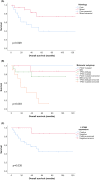Pure and mixed clear cell carcinoma of the endometrium: A molecular and immunohistochemical analysis study
- PMID: 37081760
- PMCID: PMC10278528
- DOI: 10.1002/cam4.5937
Pure and mixed clear cell carcinoma of the endometrium: A molecular and immunohistochemical analysis study
Abstract
Background: Uterine clear cell carcinoma (CCC) consists of either pure clear cell histology but can also display other histological components (mixed uterine CCCs). In this study, the molecular and immunohistochemical background of pure and mixed uterine CCC was compared. Secondly, it was evaluated whether histological classification and molecular background affected clinical outcome.
Methods: A retrospective multicenter study was performed comparing pure uterine CCCs (n = 22) and mixed uterine CCCs (n = 21). Targeted next-generation sequencing using a 12-gene targeted panel classified cases as polymerase-ε (POLE) mutated, microsatellite instable (MSI), TP53 wildtype or TP53 mutated. Immunohistochemistry was performed for estrogen receptor, progesterone receptor, L1 cell adhesion molecule, MSH6, and PMS2.
Results: The following molecular subgroups were identified for pure and mixed uterine CCCs, respectively: POLE mutated 0% (0/18) and 6% (1/18); MSI in 6% (1/18) and 50% (9/18); TP53 wildtype in 56% (10/18) and 22% (4/18); TP53 mutated in 39% (7/18) and 22% (4/18) (p = 0.013). Patients with mixed CCCs had improved outcome compared to patients with pure CCCs. Frequent TP53 mutations were found in pure CCCs and frequent MSI in mixed CCCs, associated with clinical outcome.
Conclusion: Pure and mixed uterine CCCs are two entities with different clinical outcomes, which could be explained by different molecular backgrounds. These results underline the relevance of both morphological and molecular evaluation, and may assist in tailoring treatment.
Keywords: clear cell carcinoma; endometrial cancer; molecular classification.
© 2023 The Authors. Cancer Medicine published by John Wiley & Sons Ltd.
Conflict of interest statement
None declared.
Figures


Similar articles
-
Molecular Landscape of Mullerian Clear Cell Carcinomas Identifies The Cancer Genome Atlas-like Prognostic Subgroups.Mod Pathol. 2023 May;36(5):100123. doi: 10.1016/j.modpat.2023.100123. Epub 2023 Feb 4. Mod Pathol. 2023. PMID: 36857998
-
Clear cell carcinoma of the endometrium: an immunohistochemical and molecular analysis of 45 cases.Hum Pathol. 2019 Oct;92:10-17. doi: 10.1016/j.humpath.2019.06.005. Epub 2019 Jun 30. Hum Pathol. 2019. PMID: 31269413
-
Immunohistochemical Comparison of Ovarian and Uterine Endometrioid Carcinoma, Endometrioid Carcinoma With Clear Cell Change, and Clear Cell Carcinoma.Am J Surg Pathol. 2015 Aug;39(8):1061-9. doi: 10.1097/PAS.0000000000000436. Am J Surg Pathol. 2015. PMID: 25871622
-
Clear cell endometrial carcinomas with mismatch repair deficiency have a favorable prognosis: A systematic review and meta-analysis.Gynecol Oncol. 2021 Sep;162(3):804-808. doi: 10.1016/j.ygyno.2021.07.007. Epub 2021 Jul 12. Gynecol Oncol. 2021. PMID: 34266691
-
Does a p53 "Wild-type" Immunophenotype Exclude a Diagnosis of Endometrial Serous Carcinoma?Adv Anat Pathol. 2018 Jan;25(1):61-70. doi: 10.1097/PAP.0000000000000171. Adv Anat Pathol. 2018. PMID: 28945609 Review.
Cited by
-
Unsolved Issues in the Integrated Histo-Molecular Classification of Endometrial Carcinoma and Therapeutic Implications.Cancers (Basel). 2024 Jul 4;16(13):2458. doi: 10.3390/cancers16132458. Cancers (Basel). 2024. PMID: 39001520 Free PMC article. Review.
References
-
- Ferlay J, Colombet M, Soerjomataram I, et al. Cancer incidence and mortality patterns in Europe: estimates for 40 countries and 25 major cancers in 2018. Eur J Cancer. 2018;103:356‐387. - PubMed
-
- Amant F, Moerman P, Neven P, Timmerman D, Van Limbergen E, Vergote I. Endometrial cancer. Lancet. 2005;366(9484):491‐505. - PubMed
-
- Hasegawa K, Nagao S, Yasuda M, et al. Gynecologic Cancer InterGroup (GCIG) consensus review for clear cell carcinoma of the uterine corpus and cervix. Int J Gynecol Cancer. 2014;24(9 Suppl 3):S90‐S95. - PubMed
Publication types
MeSH terms
Substances
LinkOut - more resources
Full Text Sources
Research Materials
Miscellaneous

